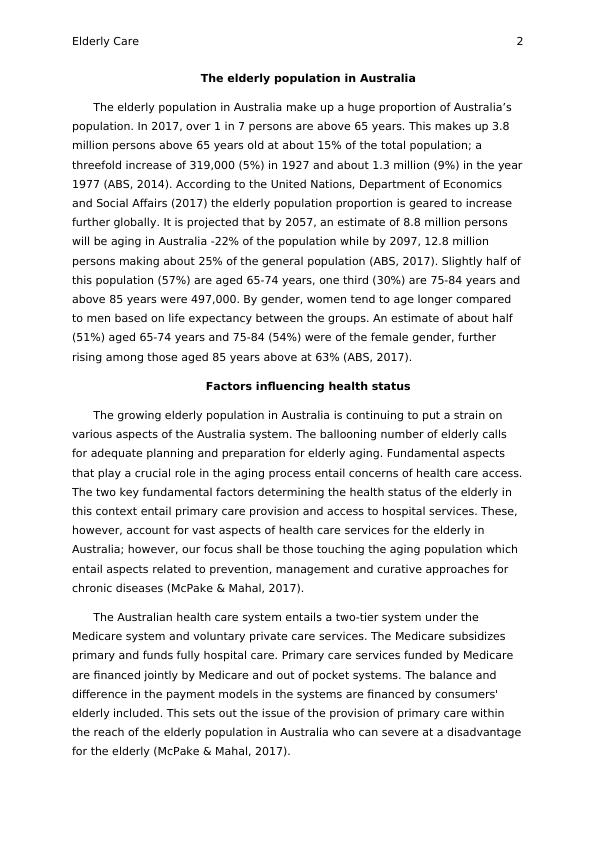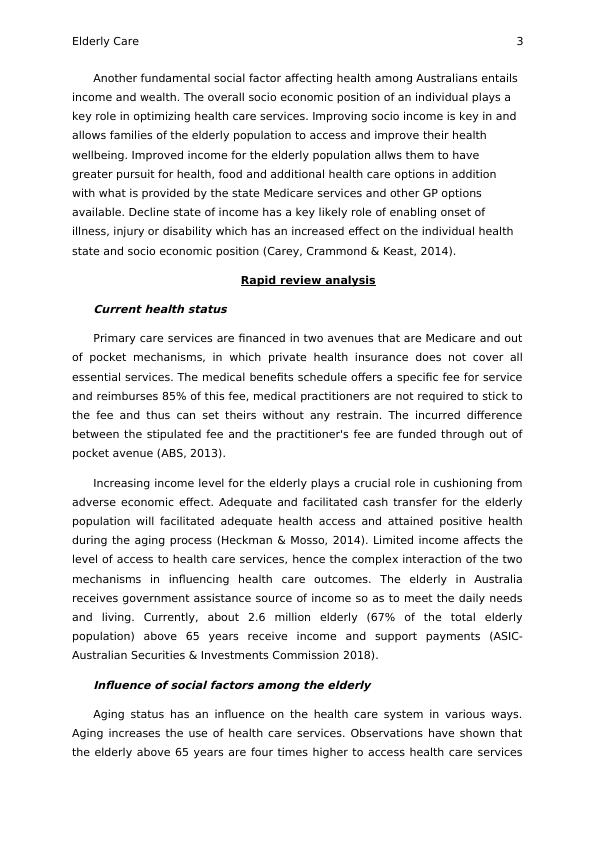Health care among the Elderly above 65
Added on 2022-09-05
7 Pages1771 Words25 Views
Health care among the Elderly above 65 years in Australia
Name
Date
Name
Date

Elderly Care 2
The elderly population in Australia
The elderly population in Australia make up a huge proportion of Australia’s
population. In 2017, over 1 in 7 persons are above 65 years. This makes up 3.8
million persons above 65 years old at about 15% of the total population; a
threefold increase of 319,000 (5%) in 1927 and about 1.3 million (9%) in the year
1977 (ABS, 2014). According to the United Nations, Department of Economics
and Social Affairs (2017) the elderly population proportion is geared to increase
further globally. It is projected that by 2057, an estimate of 8.8 million persons
will be aging in Australia -22% of the population while by 2097, 12.8 million
persons making about 25% of the general population (ABS, 2017). Slightly half of
this population (57%) are aged 65-74 years, one third (30%) are 75-84 years and
above 85 years were 497,000. By gender, women tend to age longer compared
to men based on life expectancy between the groups. An estimate of about half
(51%) aged 65-74 years and 75-84 (54%) were of the female gender, further
rising among those aged 85 years above at 63% (ABS, 2017).
Factors influencing health status
The growing elderly population in Australia is continuing to put a strain on
various aspects of the Australia system. The ballooning number of elderly calls
for adequate planning and preparation for elderly aging. Fundamental aspects
that play a crucial role in the aging process entail concerns of health care access.
The two key fundamental factors determining the health status of the elderly in
this context entail primary care provision and access to hospital services. These,
however, account for vast aspects of health care services for the elderly in
Australia; however, our focus shall be those touching the aging population which
entail aspects related to prevention, management and curative approaches for
chronic diseases (McPake & Mahal, 2017).
The Australian health care system entails a two-tier system under the
Medicare system and voluntary private care services. The Medicare subsidizes
primary and funds fully hospital care. Primary care services funded by Medicare
are financed jointly by Medicare and out of pocket systems. The balance and
difference in the payment models in the systems are financed by consumers'
elderly included. This sets out the issue of the provision of primary care within
the reach of the elderly population in Australia who can severe at a disadvantage
for the elderly (McPake & Mahal, 2017).
The elderly population in Australia
The elderly population in Australia make up a huge proportion of Australia’s
population. In 2017, over 1 in 7 persons are above 65 years. This makes up 3.8
million persons above 65 years old at about 15% of the total population; a
threefold increase of 319,000 (5%) in 1927 and about 1.3 million (9%) in the year
1977 (ABS, 2014). According to the United Nations, Department of Economics
and Social Affairs (2017) the elderly population proportion is geared to increase
further globally. It is projected that by 2057, an estimate of 8.8 million persons
will be aging in Australia -22% of the population while by 2097, 12.8 million
persons making about 25% of the general population (ABS, 2017). Slightly half of
this population (57%) are aged 65-74 years, one third (30%) are 75-84 years and
above 85 years were 497,000. By gender, women tend to age longer compared
to men based on life expectancy between the groups. An estimate of about half
(51%) aged 65-74 years and 75-84 (54%) were of the female gender, further
rising among those aged 85 years above at 63% (ABS, 2017).
Factors influencing health status
The growing elderly population in Australia is continuing to put a strain on
various aspects of the Australia system. The ballooning number of elderly calls
for adequate planning and preparation for elderly aging. Fundamental aspects
that play a crucial role in the aging process entail concerns of health care access.
The two key fundamental factors determining the health status of the elderly in
this context entail primary care provision and access to hospital services. These,
however, account for vast aspects of health care services for the elderly in
Australia; however, our focus shall be those touching the aging population which
entail aspects related to prevention, management and curative approaches for
chronic diseases (McPake & Mahal, 2017).
The Australian health care system entails a two-tier system under the
Medicare system and voluntary private care services. The Medicare subsidizes
primary and funds fully hospital care. Primary care services funded by Medicare
are financed jointly by Medicare and out of pocket systems. The balance and
difference in the payment models in the systems are financed by consumers'
elderly included. This sets out the issue of the provision of primary care within
the reach of the elderly population in Australia who can severe at a disadvantage
for the elderly (McPake & Mahal, 2017).

Elderly Care 3
Another fundamental social factor affecting health among Australians entails
income and wealth. The overall socio economic position of an individual plays a
key role in optimizing health care services. Improving socio income is key in and
allows families of the elderly population to access and improve their health
wellbeing. Improved income for the elderly population allws them to have
greater pursuit for health, food and additional health care options in addition
with what is provided by the state Medicare services and other GP options
available. Decline state of income has a key likely role of enabling onset of
illness, injury or disability which has an increased effect on the individual health
state and socio economic position (Carey, Crammond & Keast, 2014).
Rapid review analysisCurrent health status
Primary care services are financed in two avenues that are Medicare and out
of pocket mechanisms, in which private health insurance does not cover all
essential services. The medical benefits schedule offers a specific fee for service
and reimburses 85% of this fee, medical practitioners are not required to stick to
the fee and thus can set theirs without any restrain. The incurred difference
between the stipulated fee and the practitioner's fee are funded through out of
pocket avenue (ABS, 2013).
Increasing income level for the elderly plays a crucial role in cushioning from
adverse economic effect. Adequate and facilitated cash transfer for the elderly
population will facilitated adequate health access and attained positive health
during the aging process (Heckman & Mosso, 2014). Limited income affects the
level of access to health care services, hence the complex interaction of the two
mechanisms in influencing health care outcomes. The elderly in Australia
receives government assistance source of income so as to meet the daily needs
and living. Currently, about 2.6 million elderly (67% of the total elderly
population) above 65 years receive income and support payments (ASIC-
Australian Securities & Investments Commission 2018).Influence of social factors among the elderly
Aging status has an influence on the health care system in various ways.
Aging increases the use of health care services. Observations have shown that
the elderly above 65 years are four times higher to access health care services
Another fundamental social factor affecting health among Australians entails
income and wealth. The overall socio economic position of an individual plays a
key role in optimizing health care services. Improving socio income is key in and
allows families of the elderly population to access and improve their health
wellbeing. Improved income for the elderly population allws them to have
greater pursuit for health, food and additional health care options in addition
with what is provided by the state Medicare services and other GP options
available. Decline state of income has a key likely role of enabling onset of
illness, injury or disability which has an increased effect on the individual health
state and socio economic position (Carey, Crammond & Keast, 2014).
Rapid review analysisCurrent health status
Primary care services are financed in two avenues that are Medicare and out
of pocket mechanisms, in which private health insurance does not cover all
essential services. The medical benefits schedule offers a specific fee for service
and reimburses 85% of this fee, medical practitioners are not required to stick to
the fee and thus can set theirs without any restrain. The incurred difference
between the stipulated fee and the practitioner's fee are funded through out of
pocket avenue (ABS, 2013).
Increasing income level for the elderly plays a crucial role in cushioning from
adverse economic effect. Adequate and facilitated cash transfer for the elderly
population will facilitated adequate health access and attained positive health
during the aging process (Heckman & Mosso, 2014). Limited income affects the
level of access to health care services, hence the complex interaction of the two
mechanisms in influencing health care outcomes. The elderly in Australia
receives government assistance source of income so as to meet the daily needs
and living. Currently, about 2.6 million elderly (67% of the total elderly
population) above 65 years receive income and support payments (ASIC-
Australian Securities & Investments Commission 2018).Influence of social factors among the elderly
Aging status has an influence on the health care system in various ways.
Aging increases the use of health care services. Observations have shown that
the elderly above 65 years are four times higher to access health care services

End of preview
Want to access all the pages? Upload your documents or become a member.
Related Documents
Community Healthcare Services for Australia's Ageing Populationlg...
|24
|2578
|211
National Framework for Action on Dementia 2015-2019lg...
|13
|3695
|489
Prevalence of Cardiovascular Diseases in Elderly People in Australialg...
|15
|3653
|295
Policy and Practice in the Care of Older People Name Lecturer Course Date Policy on the Relocation of the Elderly Persons into the Residential Accommodation TYPE OF DOCUMENTlg...
|18
|3946
|117
National Palliative Care Strategy for Aged Population in Australialg...
|28
|8111
|173
Aged Care Nursing in Australia Despitelg...
|14
|3720
|27
